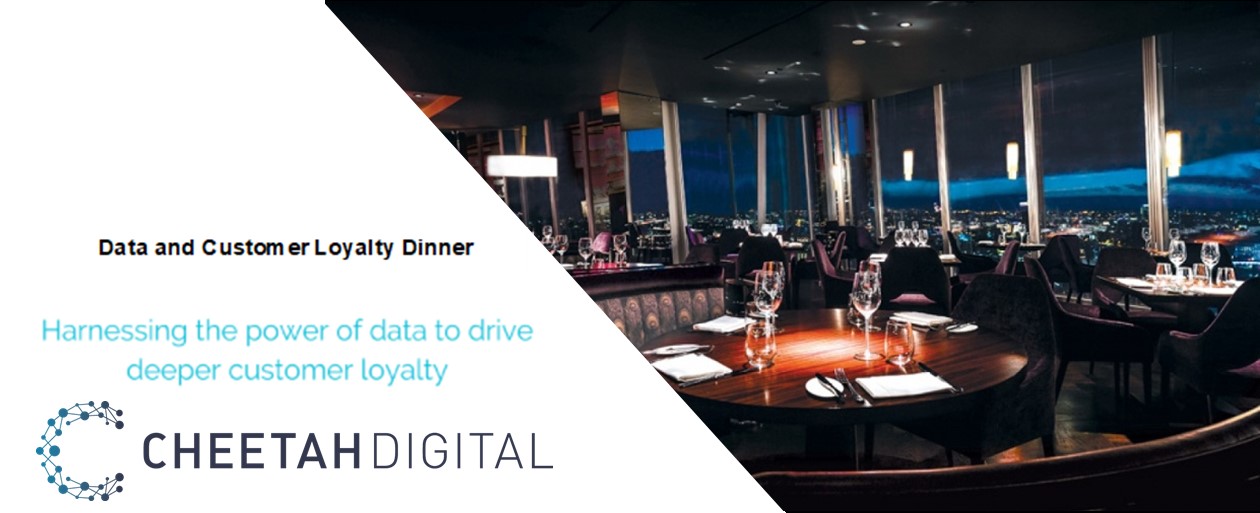The data and customer loyalty dinner took place on the 31st of January at the Shard. It was held in partnership with Cheetah Digital and aimed to tease out the best ways to use data to maximise customer loyalty.
Cheetah Digital is about speed; the idea is to empower marketers by taking the relevant customer data to their fingertips. They were therefore well placed to provide expertise about data and customer loyalty.
Some of the points discussed included:
- What are the barriers that prevent companies from capturing the full value of customer data?
- How do we unearth deeper insight into customer behaviours?
- How can we improve retention and allocate customer loyalty effectively?
If you’re going to collect my data, do it well
What do customers want?
As culture resettles over what level of data collection is considered ‘normal’, there are still criticisms of creepiness when business gets it wrong. A recent Spotify advertising campaign publicised the listening habits of (unnamed) individuals, which attracted criticism. But some people also liked the campaign; there is not yet unanimity on when people feel intruded upon.
One thing which confuses businesses is the presumption that the level of data collection is the sole variable in this. But it’s also about tone. How do you remind customers you have their data? What brand tones are you striking alongside that reminder?
Intuitively, a professional formal tone might be fine in the context of intimate data collection, like a Doctor. Perhaps what Spotify got wrong was using intimate data to strike a matey tone; a presumption. Intimate data use in the context of aggressively commercial messages may also irritate customers. (Read a previous blog on how brands mistake intimate data relationships with customers for “friendships”).
Since brands vary, there is no unanimous data policy that will feel appropriate for every business-customer relationship. However, it’s vital that intelligent brand strategy is applied to customer journeys as the give-and-get of data takes place in the context of a relationship, understood and consented to by both sides.
There’s a reason that this becomes more of a marketing/communications question than a question of whether to collect data in the first place. The benefits of collecting data are now widely understood, including by customers. They prefer messages to be inbound; to be personalised to them and their issues; and to be frictionless.
(A great example of this is demonstrated by responses to Amazon’s announcement that they may move into healthcare. One blogger said, “on the one hand; they already have enough of my personal data. On the other, where can I sign up?”).
Mismanagement and incompetence are therefore bigger enemies than aggression, when it comes to data collection. Asking repeatedly for the same data, offering customers irrelevant services, and the generally lower standard of service via failure to effectively use collected data, all affect business to a greater extent than the worrisome ‘creepiness’ aspect.
With a good enough data architecture, there’s no reason a business couldn’t react to the personal attitudes of a customer, too (ie. to personalise your levels of personalisation). Key to this is measuring negative customer responses as well as positive. Ask not just where you are making the sale; but where are you actively aggravating people. This is a key starting point for building a great customer loyalty strategy and a data infrastructure to match.
How I learned to stop worrying and love the data
The “uncanny valley” concept is something known by animators; it goes that as drawings become more like real faces, they become more dissonant; something starts to feel “off”. Machine learning, and personalisation, which are coming closer to building a new kind of relationship between people and companies, do occasionally still make choices which feel “off.”
But the dissonance of this will reduce over time. At any rate, there’s a natural road map which slowly pushes people in the direction of a machine learning infrastructure. First, people try with A/B tests and rule-based experiments. Then, the rule-based experiments will be too much data for an individual to run. Then, people start to build computer models and automate them. Finally, the entire pie is shifted finally to the data scientists.
This requires sensitive management, because different blocs of people will wax and wane in importance within an organisation. Data-centric roles are becoming more and more widely advertised.[1] There has always previously been important work for arts-degrees marketeers with an intuitive understanding of people; they spot subtler variables, finer notes of tone, and therefore have a better grasp on the best message than a scientist armed with data and analytics.
But to beat the machines, they may have to be behavioural scientists. Any marketeer familiar with analytics will know that why message “X” is 60% more successful than message “Y” is not always easily knowable to humans, either on a rule-based or an intuitive basis. Machines may be able to tease this out; and importantly, can more quickly adapt when it becomes clear that message Y is more successful.
Blocs of employees who feel threatened by these changes may hoard valuable assets such as “their” customer data; when the company requires a pool of data to which all departments have access. It is the task of management to pave the way to a data infrastructure which is flexible, adaptable, intuitive, and can be used by all employees.
The destination
Simplicity is genius, and a kind of lie. Intuitive and simple user experiences require complex machinations and contortions on the part of a product or service provider. “It’s so easy!” is very hard.
Businesses must data-collect and automate to provide this. Customer loyalty will evaporate when accessing the service or changing settings becomes difficult, unintuitive, or when the thing a customer is looking for isn’t at their fingertips.
This is especially true for many products which involve intellectual property or a service of some kind, because a lot of free alternatives are available, so a product must be that much easier than the alternative. Paying for some SaaS products, such as Spotify, can feel like a defeat. But once people have taken the plunge, it can be liberating. Spotify competes with a YouTube-cum-adblocker combination which can deliver the same reserve of music, for free. It has to be excellent to justify itself, via excellent command of customer data. That is the key to retaining loyalty in 2018.
[1] Nimbus NInety Digital Trends Report 2018, pg.36. Data from reed.co.uk




Leave a Comment